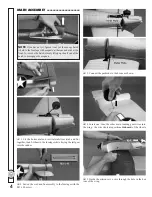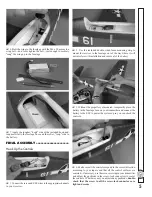
8
MOTOR/ESC OPERATION –––––––––––––
Turning on the transmitter and operating the motor are intuitive
for most pilots who already have experience with electric motors,
but for those who may have little or no experience with electric
motors here are operating instructions for the ESC and motor
included with your Hellcat:
When ready to run up the motor,
fi rst
turn on the transmitter and
make sure the throttle stick is all the way down. Then connect
the battery to the ESC. The ESC will send a single, short pulse
to the motor, causing it to beep once (“beep”). To operate the
motor advance the throttle stick, hold it there momentarily, and
listen for another single beep (“beep”). Then return the throttle
stick all the way down.The motor will sound two more quick
beeps (“beep beep”). The next time the throttle stick is advanced,
the propeller will turn. You are now ready to
fl
y.
If the transmitter is
not
turned on before the battery and ESC
are connected (so the receiver is not receiving a signal), the
motor will beep rapidly (“beep beep beep beep…”) until either
the battery is disconnected or the transmitter is turned on. Then,
the ESC will resume its normal arming sequence.
If, when the battery is connected to the ESC, the throttle stick
is not all the way down the motor will beep steadily (“beep,”
“beep,” “beep…”) until either the battery is disconnected or the
throttle stick is returned to the off position. This time the ESC
will resume its normal arming sequence.
FLYING –––––––––––––––––––––––––––––––––
The Hellcat doesn’t exhibit any particular characteristics that you
need to be made aware of ahead of time, other than it is a slightly
“draggy” airframe that will bene
fi
t from a few clicks of throttle
while dragging it in for a landing—just let the Hellcat settle and
it will touch down smoothly. Then, cut the throttle.
Flying “normally,” the Hellcat consumes approximately 250mAh/
minute which should provide approximately 6-1/2 to 7 minutes of
motor run time on a 2100mAh battery—of course, the run time
you can expect depends on many factors such as the condition
of your batteries, your
fl
ying style and even the wind conditions
(
fl
ying on windy days seems to use more power than
fl
ying on
calm days).
To
fi
nd out for yourself how long you can
fl
y, set your timer to
a conservative 5 minutes. Fly until the timer sounds, then land.
Use a charger with a digital display to
fi
nd out how much capacity
it took to recharge the battery (indicating how much capacity
was used). To avoid over discharging your LiPos, likely causing
reduced performance, the target is to use 80% of your battery’s
capacity, so multiply your battery’s capacity by .8 to
fi
nd out how
much you have available. Compare the capacity used to 80% of
your battery’s capacity and adjust your
fl
ight time accordingly.
FOR EXAMPLE:
If using the recommended 2100mAh battery,
your target capacity available is 1680mAh (2100mAh x .8). If you
fl
y for
fi
ve minutes and it takes 1200mAh to recharge your battery,
you still had 480mAh to go, so adjust your timer to increase your
fl
ight time accordingly until you reach your 1680mAh target.
(You could also divide 1200mAh by
fi
ve minutes to
fi
gure a
current consumption rate of 240mAh/minute. Divide 1680mAh
by 240mAh/minute to conclude that you can
fl
y for 7 minutes.)
It’s also a great idea to use a LiPo battery checker (HCAP0275)
to check the battery
before
each
fl
ight (to make sure you haven’t
inadvertently grabbed a discharged battery) and to check the
battery
after
fl
ight to make sure you haven’t over discharged
your battery by
fl
ying too long. A safe, conservative, minimum
voltage is 3.65V – 3.7V per cell right after a
fl
ight.
REPAIRS –––––––––––––––––––––––––––––––
Parts damaged beyond repair can be purchased separately. The
full replacement part list is printed in the front of the manual on
page 3. Often though, parts can be repaired and you can get your
Hellcat back into the air with a little glue and ingenuity.
The Hellcat is made from injection-molded EPO (expanded
polyole
fi
n) foam which can be glued with just about anything.
Most people use regular CA. With CA no clamping is required,
but some prefer softer, more
fl
exible adhesives such as white
glue or canopy glue. These kinds of glues will require clamps
or tape to hold the parts together while the glue dries.
One
fi
nal note about
fl
ying your model. Have a goal or
fl
ight plan
in mind for
every
fl
ight. This can be learning a new maneuver(s),
improving a maneuver(s) you already know, or learning how
the model behaves in certain conditions (such as on high or low
rates). This is not necessarily to improve your skills (
though it is
never a bad idea!)
, but more importantly so you do not surprise
yourself by impulsively attempting a maneuver and suddenly
fi
nding that you’ve run out of time, altitude or airspeed. Every
maneuver should be deliberate, not impulsive. For example, if
you’re going to do a loop, check your altitude, mind the wind
direction (anticipating rudder corrections that will be required to
maintain heading), remember to throttle back at the top, and make
certain you are on the desired rates (high/low rates). A
fl
ight plan
greatly reduces the chances of crashing your model just because
of poor planning and impulsive moves.
Remember to think.
Have a ball! But always stay in control and fl y in a safe manner.
GOOD LUCK AND GREAT FLYING!
This model belongs t
o
:
Name
A
ddr
ess
Cit
y, Stat
e,
Zip
Phone Number
AM
A Number


























